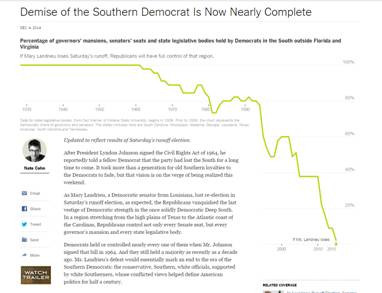Deception & Misdirection
Your own lyin’ eyes
[Continuing our series on deception in politics and policy.]
Last year, I wrote about Type B deception—a form of deception that can be so powerful, it works even after it has been exposed.
Here’s how I described it (http://capitalresearch.org/2013/04/that-arms-race/):
. . . Edward J. Epstein calls [it] “Type B deception” – a type of deception aimed at “distorting the interpretation of the meaning of a pattern of data, rather than at the observable data itself. Type B deceptions are designed to confuse, confound or mislead the cognitive processes of an adversary. Type B deception need not rely on camouflage or concealment.”
In Type B deception, the more closely one observes, the more likely one is to be fooled, as when Hitler convinced himself (with Allied help) that the Normandy invasion was a carefully planned deception and refused, day after day, to let himself be tricked by it. Supporters of President Obama’s policies often point to the failure of those policies, from the “stimulus” to support for the “Arab Spring,” as proof that the President’s ideas weren’t followed with enough zeal. People who believe that Sarah Palin and the Tea Party movement are racist see the election, due to Palin/Tea Party support, of the majority of the country’s “nonwhite” governors and U.S. senators as vindication of their belief (because those officials are Republicans, therefore Uncle Toms and traitors to others of their ethnicities). James Hansen, a leading proponent of the theory of catastrophic man-made Global Warming, wrote recently in the Washington Post that the failure of Global Warming theory to predict actual events meant that proponents of Global Warming theory were even more correct about the threat than they had realized.
Here’s an example that shows how our brains are hard-wired to “see” certain things. Which square is darker, A or B?

Are you sure?
Really sure?
Because they’re the same shade.

In this case, our brains assume that Square B, which is apparently in shadow, is actually lighter than Square A, which is apparently in direct light. Our brains “correct” the image in order for the image to make sense.
Look back at the first image. It still looks as if the two squares are different shades, even though you know the trick.
That’s Type B deception.
When temperature and carbon-dioxide records show that Global Warming theory is wrong, Warmers double-down, accusing their critics of being “deniers” (likening them to Nazi sympathizers denying the Holocaust) and demanding that skeptics be banned from writing for newspapers or getting money from corporations that fund nonprofits. (Then, as evidence that almost every knowledgeable person shares their beliefs, they point to the fact that people are reluctant to come forward as skeptics …which they are, because skeptics know that, if they come forward, they will be stigmatized as the equivalent of Nazis.)
As seen at http://www.breitbart.com/Big-Hollywood/2014/12/03/investigation-lena-dunhams-republican-rapist-story-falls-apart-under-scrutiny, journalists raised questions about the claim in a book by writer/actor Lena Dunham that she had been raped by a stereotypically boorish conservative Republican radio personality named Barry (at Oberlin College, where openly conservative Republicans of any type are too rare to escape notice). They were accused of hating women and supporting the “rape culture” on college campuses. When the music tabloid Rolling Stone—which regularly smears Republicans, conservatives, Tea Party people, Global Warming skeptics, and other non-Leftists—published a fantastical story about a rape at the University of Virginia, a story that now stands exposed as a fabrication, UVA’s administrators and the media as a whole simply took it as true and acted accordingly. Julia Horowitz, assistant managing editor of the student newspaper, defended her paper in an article in the publication Politico (http://www.politico.com/magazine/story/2014/12/why-we-believed-jackies-story-113365.html):
For 17 days, we by and large believed Jackie’s story, maintaining only a few fragments of doubt. We were frustrated by the repeated use of the “Rugby Road” song, which appeared to make fun of the rape culture on campus but which most students, in fact, had never heard. We were angered by the portrayal of administrators we had worked with and personally trusted. We were slightly apprehensive at the article’s claim the rape had taken place as part of pledging, noting that pledging takes place in the spring and not the fall. But on the whole, we did not question Jackie herself. And that’s because, when we sorted through Erdely’s snide tone and some small missteps, we found something in that article that struck a chord with us.
This is not to say that it does not matter whether or not Jackie’s story is accurate. There is now a police investigation into the incident. Brothers of Phi Kappa Psi were moved out of their house after students threw bricks through the windows. Dean Nicole Eramo has received death threats. And it is becoming increasingly clear that the story that blew the lid off campus sexual assault has some major, major holes.
Ultimately, though, from where I sit in Charlottesville, to let fact checking define the narrative would be a huge mistake. “These events undoubtedly do occur here,” first-year Maddie Rita told me. “And while this report has clearly had factual flaws as well as rhetorical missteps, there are plenty of other fully corroborated accounts not only at this university, but at every university around the country.”
How much do you want to bet that some of those who refused “to let fact checking define the narrative” will go on to long and successful careers in the major media?
Thousands march through the streets raising their hands and chanting “Hands up! Don’t shoot!”—the fake meme arising from the case of Michael Brown, who was shot in Ferguson, Missouri immediately after assaulting an Indian-American store clerk and a police officer. (There are six witnesses to the Brown shooting whose stories matched the forensic evidence. Not one of the six said they saw Brown raise his hands in surrender.) The death of Eric Garner in New York, which, in my opinion, was the result of criminal negligence, but which featured no known indication of racial discrimination, is linked to the fake “Hands up!” meme in order to make political points. It’s just one falsehood after another.
Lyndon Johnson and Mary Landrieu
Meanwhile, as the Democratic Party collapses (with its worst election nationally in 150+ years), in large part because it has lost every Senate seat, governorship, and legislative chamber in the South outside Virginia and Florida, this is handwaved as a result of racism. (For an explanation of handwaving, see http://tvtropes.org/pmwiki/pmwiki.php/Main/HandWave .)
On ABC’s Sunday morning show “This Week,” host George Stephanopoulos, who once worked for the Clintons covering up their scandals, declared: “LBJ prophesied it in 1964. Here in 2014, a Democratic wipeout in the Deep South.” This is a reference to the famous almost-certainly-fake LBJ quote about how, in signing the Civil Rights Act, he was handing the South to the Republicans.
Stephanopoulos was referring specifically to the fact that, on Saturday, Senator Mary Landrieu (D-Louisiana) lost her seat in a runoff election. Earlier, as the election approached, Nate Cohn of the New York Times began an article on the Democrats’ wipeout this way: “After President Lyndon Johnson signed the Civil Rights Act of 1964, he reportedly told a fellow Democrat that the party had lost the South for a long time to come. It took more than a generation for old Southern loyalties to the Democrats to fade, but that vision is on the verge of being realized this weekend.”
I’ve already debunked that quote, and I’ve written about how Johnson’s supposedly prophetic, visionary prediction would have been wrong even if he had actually made it. (See my previous articles on the Johnson quote, at http://capitalresearch.org/2014/10/we-have-lost-the-south-for-a-generation-what-lyndon-johnson-said-or-would-have-said-if-only-he-had-said-it/ and http://capitalresearch.org/2014/10/that-lyndon-johnson-quote-part-2/.) Others have dealt with this point, including Kevin Williamson at National Review Online (http://www.nationalreview.com/article/394137/landrieus-loss-end-epoch-kevin-d-williamson):
The Democrats, being intellectually dishonest, cling to the myth that the two parties “switched places” on racial issues in the 1960s, that Senator Landrieu’s troubles are a consequence of that reversal, and that the general Southern realignment is evidence that the Republican party is a comfortable home for bigots, Confederate revanchists, and others with dodgy racial politics.
This is a strange line of argument, and an indefensible one once the evidence is considered. Democrats remained the favored party in the South for decades and decades after the passage of the landmark Civil Rights Act of 1964, controlling a majority of governorships, Senate seats, state legislative bodies, etc., well into the 21st century.
A few obvious questions: If white Southerners were really so enraged about the Civil Rights Act of 1964, and if they switched to the Republican party to express their displeasure, then why did they wait 30 years before making that preference felt in House elections? Why did Dwight D. Eisenhower — a supporter of civil-rights legislation who insisted on the actual desegregation of the armed forces (as opposed to President Truman’s hypothetical desegregation) and federal agencies under his control — win a larger share of the Southern vote in 1956 than Barry Goldwater, the most important Republican critic of the 1964 Civil Rights Act, did two cycles later? . . . Why didn’t Alabama have a Republican governor until 1987? And why did Louisiana wait 60 years to eliminate its last Democratic senator in favor of a candidate from the party of Condoleezza Rice, Ben Carson, Allen West, Mia Love, Tim Scott, and that not-very-white guy who serves as governor of Louisiana? White supremacy should be made of sterner stuff: Did somebody forget to tell Louisiana state senator and newly confirmed Republican Elbert Guillory that he’s black?
Strange that redneck bigots would wait for so many decades to punish the Democrats for giving up cross-burning; my own experience with that particular demographic suggests that its members do not in general have that sort of attention span.
There has, in fact, been a realignment in the party preferences of both black voters and white Southern voters — a trend that dates not to the Democrats’ decision to abandon white supremacy as a plank in their party platform but to an earlier period, namely, the New Deal. By 1946, the majority of black voters in congressional races were pulling the Democratic lever — that is, black voters switched to the Democrats at a time when Lyndon Johnson wasn’t just blocking civil-rights bills but blocking anti-lynching legislation. The last Republican presidential candidate to win the black vote was Herbert Hoover.
Similarly, the migration of white Southern voters to the GOP did not begin after the fight over the Civil Rights Act of 1964. And why would it have? Despite the principled opposition of Barry Goldwater, a lifelong NAACP member who nonetheless believed that the bill gave the federal government too much power over state and local matters, Republicans supported the Civil Rights Act of 1964 at significantly, just as Republicans, Goldwater included, had fought for the Civil Rights Act of 1957, passed on Republican votes over Democratic obstruction and signed by a Republican president.
In reality, the Republican party in the South was not the party of peckerwood-trash segregationists; the GOP made its first Southern inroads among relatively affluent, educated, suburban voters, i.e., basically the same people who were Republicans everywhere else in the country, and the Southern voters least interested in segregation. And that began in the 1920s, not the 1960s. But it really picked up during the New Deal, with Franklin D. Roosevelt’s support among Southern white voters diminishing as his Prussian-style command-and-control economic fantasies became more audacious.
…and Kevin Baker wrote in, of all places, the New York Times (http://www.nytimes.com/2014/11/16/opinion/sunday/delusions-of-the-democrats.html):
The accepted wisdom is that the Democrats hamstrung themselves many years ago, when they passed the Civil Rights Act of 1964, and thereby lost the Solid South forever. It’s a nice story, one that allows everyone to feel good: liberal Democrats, who would like to believe their party was martyred in as noble a cause as there could be, and Clinton-Obama Democrats, who have long cited it as proof that the party needs to move to the right and start appealing to conservative Southern whites again.
The only trouble is, it’s not true.
Yes, the South was never “solid” for Democrats again after 1964, and the party lost five of six presidential elections from 1968 to 1988. But at every other level of government, Democrats remained highly competitive, even dominant, in the South for years to come.
Going into the 1994 elections, Democrats still held 16 of the 30 United States Senate seats from the 15 Southern states (which I define as the 11 states of the Confederacy, plus Kentucky, Maryland, Missouri and West Virginia), and nearly two-thirds of the Southern seats in the House. On a state level, the figures were even more one-sided. Democrats held 12 of the 15 Southern governorships, and 29 of the 30 state legislative chambers.
It’s only in the last two decades that these numbers flipped. In the next Congress, fewer than a third of the South’s representatives will be Democrats; if Mary Landrieu loses her seat in Louisiana, there will be seven Democratic senators in the region. Democrats there will hold four governorships and both chambers in just one legislature.
Democrats did lose the South, but they didn’t lose it because of the Civil Rights Act. Instead of waiting for all those mean old Southern white men to die, Democrats might be better off asking themselves why so many of them were still voting Democratic just 22 years ago.
Nor have Democratic losses in the South been much worse than they were all over the country. To give just one egregious example, Democrats lost the Massachusetts statehouse this year — for the fifth time in their last seven tries.
What the chart doesn’t show
A graphic was posted with Nate Cohn’s New York Times piece to show the decline of the Democrats in the South. (Of course, the takeaway that Democrats are near-dead at the U.S. Senate/governor/legislative level in the South depends on a sleight of hand, leaving out Virginia and Florida, which together send three Democrats to the Senate. But I’ll let that slide, on the ground that both states have large sections that are more Northern that Southern culturally and politically.) Here’s what it looked like on the Times website:

Clearly, the graph is meant to back up the claim that the Democrats’ decline was rooted in LBJ’s signing of the Civil Rights Act or, as was explained in an accompanying Times piece on Landrieu by Richard Fausset, “The rise of the first black president helped accelerate the white migration to the Republicans, which was reflected in the Republican tide that swept away many surviving Democratic officeholders across the South in November.” (http://www.nytimes.com/2014/12/05/us/in-louisiana-runoff-election-senator-landrieu-tries-to-revive-her-base.html)
The graph shows no such thing. The Democrats’ decline, as seen on that chart, started in a special election early in 1961 (in which Republican John Tower took the U.S. Senate seat vacated by Vice President Johnson) and continued—more or less steadily, by the standards of political change—through the next 53 years. At the time the trend began, people were arguing over who was a bigger supporter of civil rights, the Democratic Party of John F. Kennedy (who was allied with arch-segregationist Governor John Sparkman of Alabama but who also made a call to Martin Luther King Jr. when Dr. King was wrongly jailed) or the Republican Party of Dwight D. Eisenhower (who was attacked by segregationist/Democratic newspapers in the South for sending troops to enforce desegregation in Little Rock; they said he was attacking “The Democracy,” by which they meant majority/”white”/Democratic Party rule). The trend continued through the ages of Jimmy Carter (the Democratic nominee for president a mere six years after running for governor of Georgia as a segregationist) and Bill Clinton and Barack Obama, and the presidents in-between.
Does the graph rally show that the Democrats’ decline is significantly tied to two events, the signing of the Civil Rights Act and “the rise of the first black president”? To answer that question, I did a little experiment.
I took the chart from the Times story and stripped it of all information that would show what it represented, leaving just the yellow line. I then showed the line to nine people who work in my building, and said something like this: “Here’s a timeline. It might show the population of a country, or a stock price, or something else—I’m not saying. I would like you to guess, based solely on this timeline, when the events occurred that caused the obvious decline. When were the catastrophic events? What were the turning points when things changed?” I told them to pick the two most significant moments on the chart at which events led to the decline. Then I took their responses and consolidated them on this graph:

I took their collective response and correlated it with the historical record, and I used arrows to mark the signing of the Civil Rights Act and the election of President Obama. As it turns out, the respondents focused on five key points: (a) a time before the signing of the Civil Rights Act, (b) early in the Carter administration, (c) early in the Clinton administration during the time of the Gingrich Revolution, (d) early in the Bush (43) administration, and, finally, (e) early in the Obama administration.
Remember: This was a blind experiment. The respondents were simply marking the turning points on a timeline without any knowledge of what the timeline represented.
In my opinion, the chart clearly represents a longterm decline. The Democrats’ decline in the South began in the early 1960s, when, as a general rule, Republicans were more pro-civil rights than Democrats. It accelerated when Jimmy Carter, who styled himself as a moderate/conservative to get elected, lurched to the Left. It accelerated again when Bill Clinton, elected as a moderate, tried to pass healthcare rationing (Hillarycare, an early version of Obamacare), and when Newt Gingrich, who began his political career trying to take down segregationist Democrats, was leading a revolt that would bring the GOP to power in the U.S. House for the first time in four decades. It accelerated again when George W. Bush seemed to be governing as a conservative, and especially when Democrats, not all that long after 9/11, started ridiculing him as a redneck. The final stage began when Barack Obama, the most extreme president since Woodrow Wilson, took office and succeeded in passing his disastrous healthcare rationing scheme over the strong objection of the American people.
Many Times readers will, I’m sure, look at the graph and see what they want to see, what they expect to see, and what they are told to see by the author of the accompanying article. Like good Progressives, they will see something that isn’t there. And I suspect that, as in the case of the seemingly obvious difference in shade between Square A and Square B, they will see it no matter what anyone does to expose the trick.



